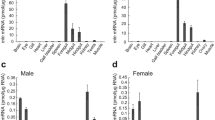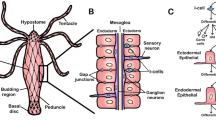Summary
The coordinated activity cycles of the heart excitor motor neurons, or HE cells, of the leech ventral nerve cord responsible for the heart tube constriction rhythm are controlled by a set of heart interneurons, or HN cells. Ganglia 3, 4, 6 and 7 of the ventral cord each contain a pair of such HN cells, which send axons into the posterior connective. On their rearward course, the HN cell axons transit through the neuropil of many posterior ganglia where they inhibit the ipsilateral HE cells. The HN cells maintain an activity rhythm consisting of an active phase, during which they are depolarized and produce a burst of impulses, and an inactive phase during which they are repolarized while receiving a burst of inhibitory synaptic potentials.
The HN cells form part of the neural oscillator that is the source of the heartbeat rhythm, since the phase of the rhythm can be shifted by evoking impulses in an HN cell during the inactive phase of its activity cycle. The HN cell activity rhythms are coordinated intra- and intersegmentally in such a manner that on the peristaltic side there is a progressive rear-to-front progression in the phase of the HN cell activity cycles and that on the non-peristaltic side the activity cycles occur in phase.
A quantitative theoretical analysis shows that the pattern of HN-HE cell synaptic links and the phase relations of the HN cell activity cycles can account for the observed phase relations of the HE activity cycles and hence ultimately also for the heart tube constriction dynamics on both peristaltic and non-peristaltic body sides.
Similar content being viewed by others
References
Alving, B.O.: Spontaneous activity in isolated somata ofAplysia pacemaker neurons. J. gen. Physiol.51, 29–45 (1968)
Eckert, R., Lux, H.D.: A voltage-sensitive persistent calcium conductance in neuronal somata ofHelix. J. Physiol. (Lond.)254, 129–152 (1976)
Kandel, E.R.: Cellular studies of learning. In: The neurosciences first study program (G.C. Quarton, ed.), pp. 666–689. New York: Rockefeller University Press 1967
Kater, S.B., Kaneko, C.R.S.: An endogenously bursting neuron in the gastropod mollusk,Helisomatrivolis. J. comp. Physiol.79, 1–14 (1972)
Kennedy, D., Mellon, D.Jr.: Synaptic activation and receptive fields in crayfish interneurons. Comp. Biochem. Physiol.13, 275–300 (1964)
Mayeri, E.: Functional organization of the cardiac ganglion of the lobster,Homarus americanus. J. gen. Physiol.62, 448–472 (1973)
Maynard, D.M.: Simpler networks. Ann. N.Y. Acad. Sci.193, 59–72 (1972)
Meech, R.W., Standen, N.B.: Potassium activation inHelix aspersa neurons under voltage clamp: A component mediated by calcium influx. J. Physiol. (Lond.)249, 211–239 (1975)
Mendelson, M.: Oscillator neurons in crustacean ganglia. Science171, 1170–1173 (1971)
Nicholls, J.G., Purves, D.: Monosynaptic chemical and electrical connections between sensory and motor cells in the central nervous system of the leech. J. Physiol. (Lond.)209, 647–667 (1970)
Perkel, D.H., Mulloney, B.: Motor pattern production in reciprocally inhibitory neurons exhibiting postinhibitory rebound. Science185, 181–183 (1974)
Selverston, A.I.: Structural and functional basis of motor generation in the stomatogastric ganglion of the lobster. Amer. Zool.14, 957–972 (1974)
Stein, P.S.G.: Neural control of interappendage phase during locomotion. Amer. Zool.14, 1003–1015 (1974)
Strumwasser, F.: The cellular basis of behavior inAplysia. J. Psych. Res.8, 237 (1971)
Thompson, W.J., Stent, G.S.: Neuronal control of heartbeat in the medicinal leech. I. Generation of the vascular constriction rhythm by heart motor neurons. J. comp. Physiol.111, 261–279 (1976a)
Thompson, W.J., Stent, G.S.: Neuronal control of heartbeat in the medicinal leech. III. Synaptic relations of the heart interneurons. J. comp. Physiol.111, 309–333 (1976b)
Wilson, D.M.: Central nervous mechanisms for the generation of rhythmic behavior in arthropods. Soc. exp. Biol. Symp.20, 199–228 (1966)
Author information
Authors and Affiliations
Additional information
We are indebted to Kenneth L. Carlock for providing us with the solution of the trigonometric equations. This research was supported by Grant No. GB 31933X from the National Science Foundation and Public Health Service Research Grant No. GM 17866 and Training Grant No. GM 01389 from the Institute of General Medical Sciences.
Rights and permissions
About this article
Cite this article
Thompson, W.J., Stent, G.S. Neuronal control of heartbeat in the medicinal leech. J. Comp. Physiol. 111, 281–307 (1976). https://doi.org/10.1007/BF00606469
Received:
Issue Date:
DOI: https://doi.org/10.1007/BF00606469




